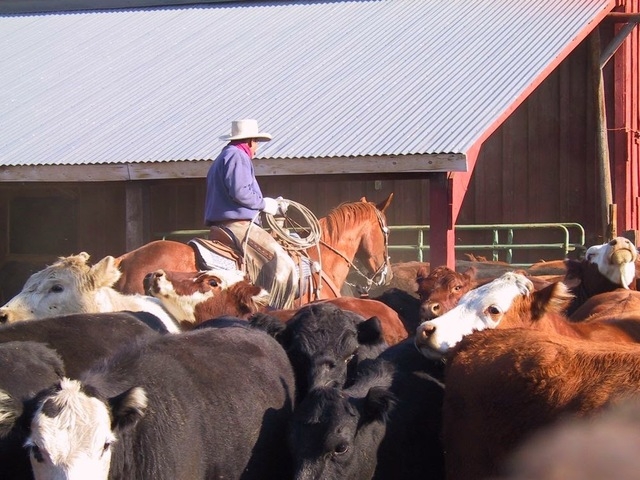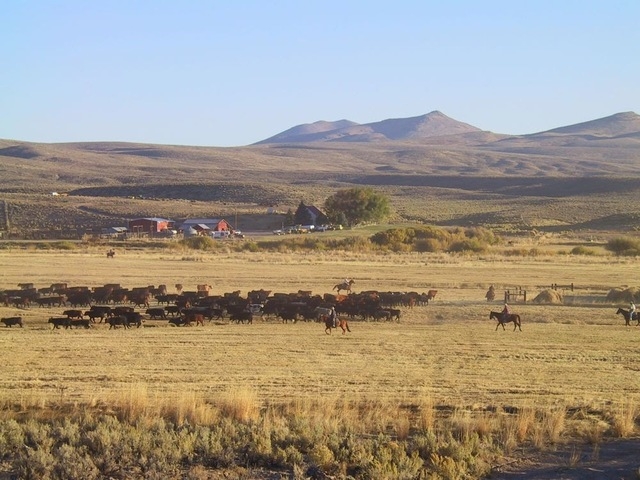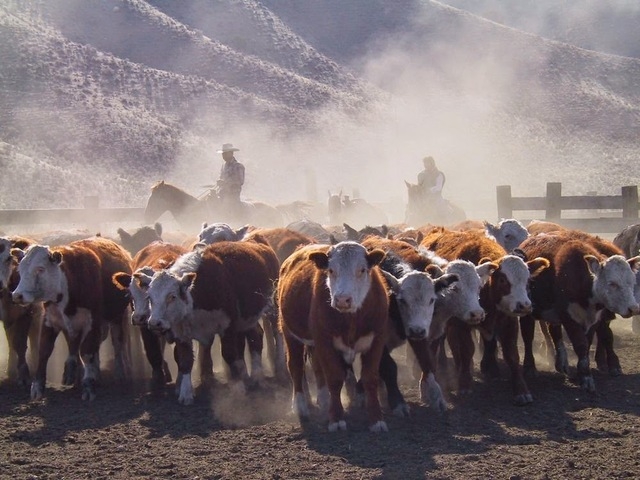Before mining and gambling, ranching shaped Nevada’s culture
Editor’s note: Nevada 150 is a yearlong series highlighting the people, places and things that make up the history of the state.
Mention Las Vegas, and people from around the world picture gambling.
Drop the name Nevada, though, and outsiders might conjure different connotations.
Thanks to decades’ worth of art, literature, TV and movies, many people beyond the Silver State link Nevada to ranching, a key part of the state’s early history and an important economic and cultural driver into the modern era.
Ranching isn’t the state’s biggest industry. You have to add up direct, indirect and induced economic benefits to push the combined agriculture and ranching industry’s impact on Nevada to $5.3 billion. That’s less than half of the $11.1 billion in gaming revenue alone that the state’s hotel-casinos brought in during 2013.
But Nevada had ranchers decades before it had pit bosses. And sheepherders were moving livestock across the terrain even before the state’s vital mining industry took hold in the 1850s.
“Ranching is the economic mainstay of Nevada’s rural communities. Before the microscopic-gold mining boom took off, rural Nevada was basically ranch,” said Ron Torell, president of the Nevada Cattlemen’s Association. “Also, even today, ranchers are stewards of large tracts of land. And to a large extent, the ranching industry played a very large role in shaping the state’s political climate.”
Perhaps as important, ranching helped give Nevada its reputation as a land of self-sufficient, resilient people who embraced the ups and downs that came with rugged individualism, said Mariah Evans, an associate professor of sociology at the University of Nevada, Reno, and a lifelong Nevadan who comes from a ranching family.
“There was this idea that you could make things happen. You didn’t have to wait for people to tell you what to do,” she said. “We’d hear all these jokes growing up about, ‘Give me a bit of baling wire, and I will make anything run.’ We could invent as we needed to. We were adaptable and foreseeing.”
Ranchers in Nevada have definitely needed to adapt. To understand why, consider the industry’s history here.
The first domestic sheep made their way across Nevada in 1841 alongside wagon trains on their way to California, according to University of Nevada researchers. During California’s Gold Rush, from the early 1850s to 1860, more than 500,000 sheep — nearly equivalent to today’s human population in the city of Las Vegas — passed through Nevada on the way to the Golden State, where they would feed hungry miners.
The state’s first resident sheepman — a rancher named C.D. Jones — settled in 1852 in the Carson Valley below Genoa. Famed frontiersman Kit Carson traveled across the state with a flock of sheep in 1853. In 1857, Prussian immigrant H.F. Dangberg built a sheep ranch on the East Carson River that continues today.
But it took the 1859 discovery of Nevada’s Comstock Lode to give ranching a serious boost. As miners flooded the state for silver, the livestock migration headed toward California turned back into Nevada, which suddenly needed its own big food supply.
Other milestones in the development of Nevada’s ranching industry were the federal Homestead Act of 1862, which let ranchers claim public land after living on it for five years, and the 1869 arrival of the Transcontinental Railroad in the north.
“If you have to walk your cattle to market, you walk a lot of condition off of them, and it takes a long time,” Evans said. “Suddenly, with the railroad, you have a very efficient way of delivering meat and high-quality condition to markets.”
Historians describe the decade from 1910 to 1920 as ranching’s golden era in Nevada. California was booming, and it provided a stable market for meat from Silver State growers. Immigrants from Germany, Holland, Denmark, Italy and Spain’s Basque region flocked to the state to set up ranches.
It wasn’t all good times, though. Harsh conditions made life untenable for some pioneering Nevada ranchers. A hard winter and overgrazed lands culled the state’s sheep flocks by 65 percent in 1879 and 1880. Another brutal winter, followed by an especially dry summer in 1889 and 1890, killed more than 130,000 cattle statewide. About 80 percent of the state’s stock in 1889 froze to death, Evans said.
“It was really a very hard life, and at that point, lots of early ranchers left for other states with easier conditions,” Evans said.
The ranchers who stayed fed a cowboy ethos that’s become lore in popular culture.
University of Nevada art professor Craig Sheppard fused cultural traditions with Japanese ink drawings of cowboys and other ranching scenes in a 1950s Paris exhibition that “probably formed the art-going classes’ views of the state forever,” Evans said.
Writer Robert Laxalt inspired festivals celebrating Basque culture across the state with his book “Sweet Promised Land,” which detailed the life of his father, Basque sheepherder Dominique Laxalt. Robert Laxalt also founded the University of Nevada Press and consulted with the Library of Congress on Basque culture.
Then there’s perhaps the best-known association between Nevada and the cowboy life: the TV show “Bonanza,” set in Virginia City. The show, which aired from 1959 to 1973, was especially popular in Europe.
Tom Harris, a professor in the University of Nevada’s Center for Resource Economics, recalls coming across several buses full of northern Europeans in Austin. What was the first thing they mentioned to him? You guessed it: “Bonanza.”
When Evans traveled the continent in the 1960s, the first thing people would ask her when she told them she was from Nevada was if she knew the location of the show’s Ponderosa Ranch. (It was mostly on Paramount soundstages in Hollywood).
“Outsiders look at us as a ranching state, even if the industry has dwindled quite a lot. You see bits of cultural residue. There are not many states where you can still find Basque restaurants,” she said.
Nevada ranchers also became important policymakers and legislators, Torell said. Another one of Dominique Laxalt’s sons, Paul, served as Nevada’s governor from 1967 to 1971 and as a U.S. senator from 1974 to 1986. Other state lawmakers active in ranching include former Assemblyman John Carpenter, R-Elko, and state Sen. Pete Goicoechea, R-Eureka.
And a rancher’s son used his political clout to set national immigration policies. U.S. Sen. Patrick McCarran sponsored several federal bills opening U.S. entry to more than 1,000 Basque sheepherders in the 1940s and ’50s to help boost a workforce depleted during World War II.
Though ranching has mostly been confined to the state’s central and northern regions, Southern Nevada has had its brush with the lifestyle.
Helen Stewart is perhaps Southern Nevada’s best-known rancher. Stewart moved in 1882 with her husband, Archibald, and their children to a ranch near what is now the intersection of Washington Avenue and Las Vegas Boulevard, where the family raised cattle and sold vegetables, fruit and wine to miners and travelers passing through the valley. Helen Stewart took over the ranch’s operation after her husband was murdered in 1884, and she expanded it to become the area’s largest landowner by 1890.
Today, you can see the family’s ranch site next to Cashman Center at the Old Las Vegas Mormon Fort State Historical Park, where a life-sized bronze statue of Helen Stewart stands at the entrance.
Helen Stewart’s ranch is a distant memory, with Southern Nevada’s economy dominated today by tourism, gambling and development. And with millions of newcomers to Nevada since 1990, some observers said they see ranching’s influence waning. Most Nevadans didn’t grow up here and don’t know the details of the state’s economic history.
“That makes the culture very difficult to maintain and support,” Evans said.
Ranchers today remain a diverse bunch. They include children of ranchers who went away to college and returned home to modernize the operation, as well as retired businesspeople from the East Coast who always dreamed of owning a ranch, Evans said. The state even has full-time corporate cowboys — complete with retirement plans — who work for ranches owned by mining giants such as Barrick Gold Corp.
“In that sense, the cowboy as an occupation is moving into the mainstream,” Evans said.
Mainstream or not, the industry has big challenges going forward.
Some of those issues have always stalked the state’s ranchers. It will never be easy to run a ranch in the nation’s driest state, Torell said. More recently, the state’s years-long drought has pushed the cost of production from $600 per cow per year to around $800, thanks to higher feed costs, bigger veterinarian bills and more cattle deaths.
Throw in the fact that the federal government heavily restricts and regulates use of the 87 percent of Nevada land it owns, and running a successful operation gets even tougher.
Nevada is also far from the main U.S. beef market in the Midwest. Not only is it pricier to get cattle from Nevada to market, but ranchers here miss out on the leftover corn stocks and other crops that feed livestock in the nation’s heartland.
“Nevada’s beef industry is going to struggle because of all of those factors,” Torell said. “You’ll see fewer and bigger operations.”
The attitude in the sector has shifted as well, Evans said.
“Ranchers themselves feel much more embattled than they used to because of the relentless hostility they felt for some decades from the Bureau of Land Management and the U.S. Forest Service,” she said. “Now, (federal agencies are) in a more cooperative mode, but they were in a hostile mode for a long time. It led to a more embattled nature than a happy one.”
Despite the industry’s challenges and its dwindling share of the state’s economy, observers say ranching will always be an essential part of Nevada’s culture.
Harris said growing middle classes in India and China will mean new markets for Nevada-raised meat. The industry will also remain vital for its lack of volatility and the economic links it provides, he said. Ranchers spend a lot of money in their communities on goods and services. Their spending holds relatively steady in good times and bad, he added.
Said Torell: “It’s still going to be very important to our rural communities. You still have to have people on the ground, and you still need stable economic forces in your rural communities, so ranching will still be an integral part of Nevada.”
Contact reporter Jennifer Robison at jrobison@reviewjournal.com or 702-380-4512. Follow @J_Robison1 on Twitter.





















